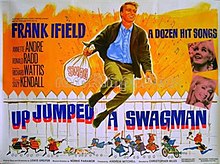Up Jumped a Swagman
| Up Jumped a Swagman | |
|---|---|

British quad poster
|
|
| Directed by | Christopher Miles |
| Produced by | Andrew Mitchell |
| Written by | Lewis Greifer |
| Starring |
Frank Ifield Annette Andre Richard Wattis |
| Music by | Norrie Paramor |
| Cinematography | Kenneth Higgins |
| Edited by | Jack Slade |
|
Production
company |
Elstree (Ivy Films)
|
| Distributed by | Warner-Pathe Distributors (UK) |
|
Release date
|
21 December 1965 (London) (UK) |
|
Running time
|
89 minutes |
| Country | UK |
| Language | English |
Up Jumped a Swagman is a 1965 British musical comedy film directed by Christopher Miles and starring Frank Ifield, Annette Andre, Ronald Radd and Suzy Kendall. DVD Release 2014 Network British Film. Songs include "Waltzing Matilda" and "I Remember You."
An aspiring Australian singer moves to London in the hope of a big breakthrough. He chases after a popular model not noticing the beautiful daughter of a pub owner who loves him. He also gets involved with a gang of thieves.
The film was made when Frank Ifield was at the height of his popularity with an attempt to reproduce the success of Cliff Richard's musicals. Ifield's agent, Leslie Grade, suggested another one of his clients, Christopher Miles as director. Miles was only 25 and had never made a feature film before. He says the script was to be written by the people who did Cliff Richard's musicals. Miles:
Unfortunately the two writers of the Cliff pictures were not then on speaking terms, so the two halves of a rather soggy script arrived separately in the post, and not surprisingly made no sense at all. So Leslie, not one to be beaten, got an old writer friend from ITV, Lewis Greifer, saying "He's the man, I know you'll get on well" which we did. However thinking up a credible vehicle for Frank, amiable and charming as he was, proved to me that ultimately you cannot make a celluloid purse out of a sow's ear, even though Frank was gamely willing to send himself up. It was going to have to be a small budget, and to save money I was asked to use a new film saving invention – the dreaded 'Techniscope' process. By only using two sprocket holes for each frame (instead of the standard four) a narrow negative was created, which had a sort of wide-screen look. However in 1965 colour film stock was still rather grainy, which showed when the final picture was blown up for the large cinema screen.
Miles says the leading lady fell pregnant before shooting started so he replaced her with Suzy Kendall (making her film debut).
...
Wikipedia
